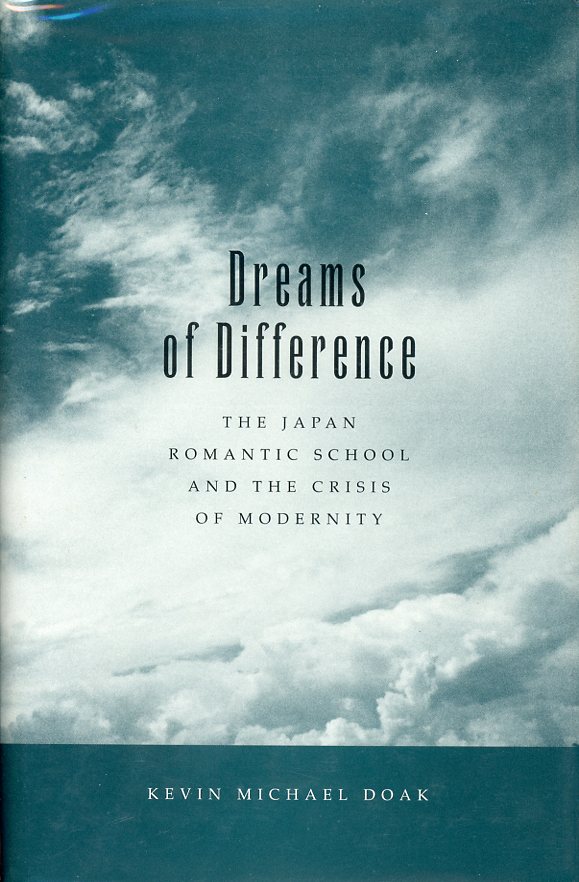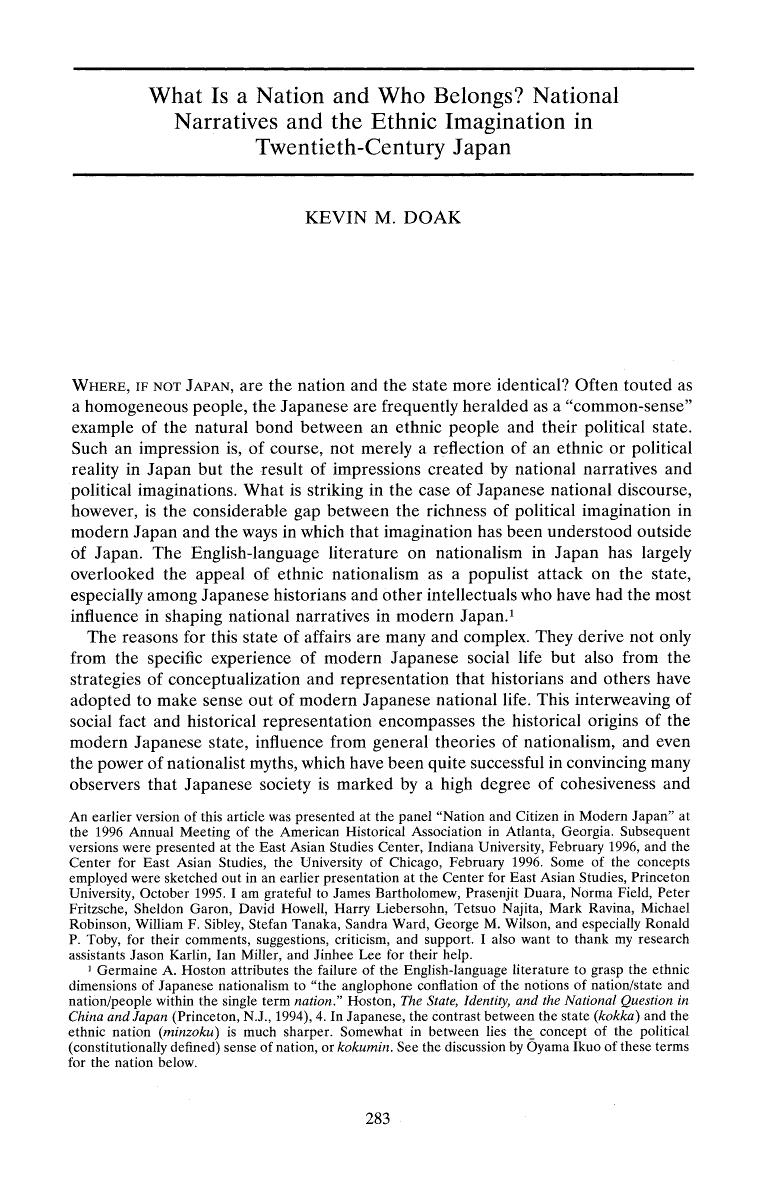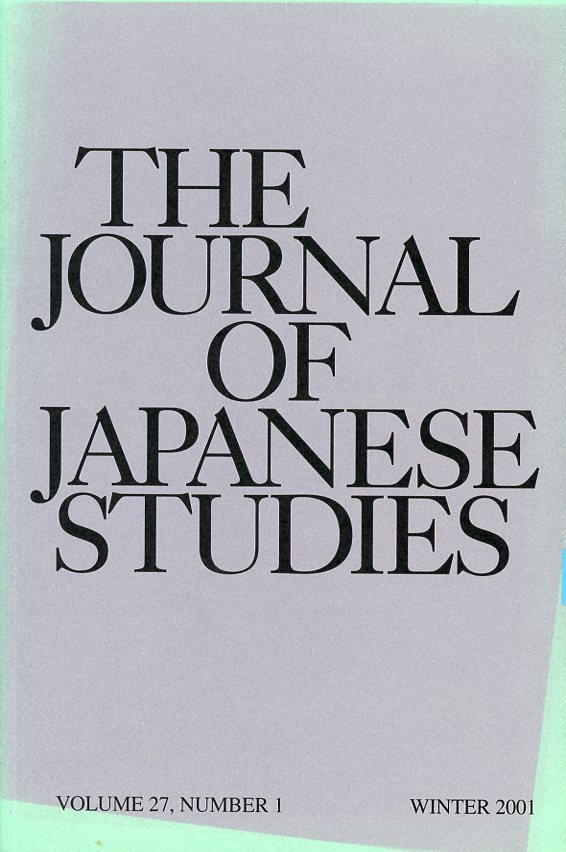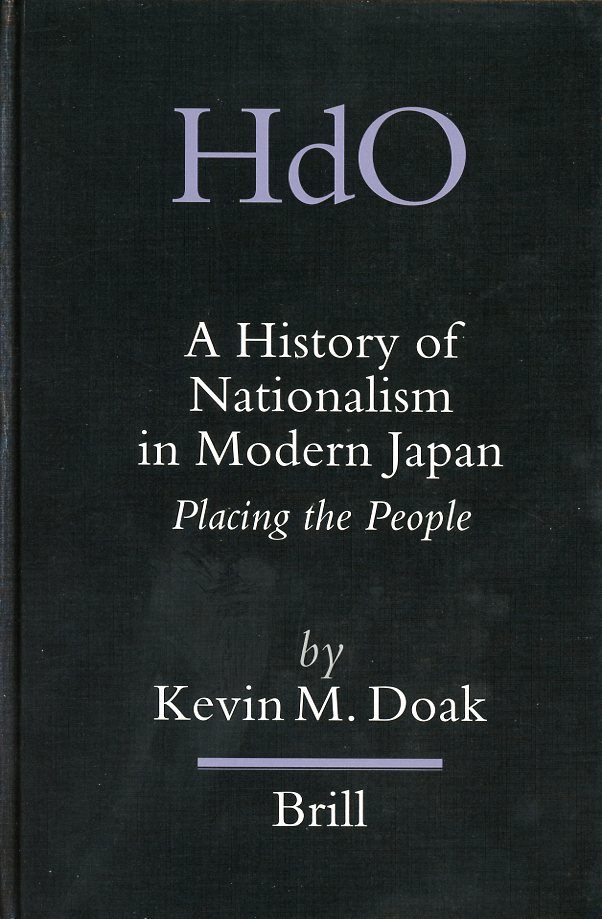1994
1997
2001
2007 |
Kevin Michael Doak
Dreams of Difference
(The Japan Romantic School and the Crisis of Modernity)
Berkeley: University of California Press, 1994
xliii, 197 pages, hardcover, jacket
Kevin M. Doak
What Is a Nation and Who Belongs?
National Narratives and the Ethnic Imagination in Twentieth-Century Japan
American Historical Review
April 1997
Pages 283-309
Kevin M. Doak
Building National identity through Ethnicity:
Ethnology in Wartime Japan and After
Journal of Japanese Studies
Winter 2001, Volume 27, Number 1
Pages 1-39
Kevin M. Doak
A History of Nationalism in Modern Japan
(Placing the People)
Handbook of Oriental Studies
Handbuch der Orientalistik [HdO]
Section Five, Japan, Volume 13
Leiden: Brill, 2007
xii, 292 pages, hardcover
|
|
These four works, but especially the last, are valuable for the insights they give into how one of the major writers in English about "nationalism" in Japan views the meanings of the Japanese equivalents of words like "nation" and "state" and "people" and "race", and how he defines who "belongs" to the "nation" or "state" which he sometimes calls the "nation-state" of Japan -- i.e., who is and isn't "Japanese".
Biographical note
Kevin M. Doak . . .
 Romantic nationalism from Meiji to Pacific War
Romantic nationalism from Meiji to Pacific War
Yosha Bunko scan
|
Doak 1994
Kevin Michael Doak
Dreams of Difference
(The Japan Romantic School and the Crisis of Modernity)
Berkeley: University of California Press, 1994
xliii, 197 pages, hardcover, jacket
Forthcoming
|
Top
 First page of "What Is a National and Who Belongs?"
First page of "What Is a National and Who Belongs?"
The American Historical Review, April 1997
Captured from Jstor
|
Doak 1997
Kevin M. Doak
What Is a Nation and Who Belongs?
National Narratives and the Ethnic Imagination in Twentieth-Century Japan
American Historical Review
April 1997
Pages 283-309
Forthcoming
|
Top
 Gray cover, green where the sun bleached out blue and red
Gray cover, green where the sun bleached out blue and red
Yosha Bunko scan
|
Doak 2001
Kevin M. Doak
Building National identity through Ethnicity:
Ethnology in Wartime Japan and After
Journal of Japanese Studies
Winter 2001, Volume 27, Number 1
Pages 1-39
Forthcoming
|
Top
 Kevin M. Doak, Leiden·Boston, 2007
Kevin M. Doak, Leiden·Boston, 2007
Yosha Bunko scan
|
Doak 2007
Kevin M. Doak
A History of Nationalism in Modern Japan
(Placing the People)
Handbook of Oriental Studies
Handbuch der Orientalistik [HdO]
Section Five, Japan, Volume 13
Leiden: Brill, 2007
xii, 292 pages, hardcover
Forthcoming
http://search.japantimes.co.jp/cgi-bin/fb20080622a1.html
Sunday, June 22, 2008
The many different ways Japan spells 'nationalism'
By YOSHIHISA TAK MATSUSAKA
Monumenta Nipponica
A HISTORY OF NATIONALISM IN MODERN JAPAN: Placing the People, by Kevin M. Doak. Leiden: Brill, 2006, 292 pp., $93 (cloth)
There is no shortage of writing about nationalism in modern Japanese history. Nonetheless, the object of investigation has not always been clear, and until recently the term "nationalism" has not been employed with much theoretical rigor. The difficulty of applying the concept to Japanese thought and politics is underscored, as Kevin Doak points out, by the multiple Japanese terms ? kokuminshugi, minzokushugi, kokkashugi, and nashonarizumu ? all translatable in English as "nationalism."
Doak's book is designed as an intellectual history of Japanese nationalism from the Meiji Era to the present. He begins with a consideration of theories of nationalism and their impact on Japanese intellectuals (with an emphasis on the 1920s and 1930s). He then explores four concepts central to the discourse: tenno (emperor), shakai (society), kokumin (author's translation, civic nation), and minzoku (author's translation, ethnic nation). The central theme of his study is the dialectic of these last two ideas, manifested ideologically as kokuminshugi (civic nationalism) and minzokushugi (ethnic nationalism).
Doak acknowledges from the start that he is redefining the subject as treated in much of the existing scholarly as well as journalistic literature. Nationalism, as he defines it, "is a principle that asserts the people as the privileged principle of political life." His emphasis is less on the construction of identity than on efforts to conceptualize the relationship between "the people" and "the state." In his view, the Japanese term "kokkashugi," better translated into the French as tatisme, ideologically centers "the state" rather than "the people" and should be excluded from the category of nationalism. Accordingly, he places outside the boundaries of treatment what others have described as the nationalism of the state or emperor-centered nationalism.
In emphasizing political philosophies concerned with the relationship of the people and the state, he also seems to downplay the importance of ideological projects aimed at placing the people of Japan in the world at large. By civic nationalism, Doak means very specifically an ideological commitment to liberal democracy and to criteria for citizenship in which ethnicity and cultural identity are explicitly irrelevant ? an ideal that closely resembles the American national imaginary.
Given that the full and consistent development of such civic values is a relatively recent development even in the world's most liberal and democratic societies, it is not surprising that this category in Japan is thinly populated for much of the span of the narrative; prominent only at the beginning, best represented by Christian thinkers of the early and middle Meiji Era and exemplified at the end by public intellectuals such as Masao Maruyama of the early postwar era.
In contrast to this rather narrow definition of civic nationalism, Doak's construction of the ethnic variety is remarkably broad. It includes the primordial blood-and-soil concepts of national identity commonly associated with the term as well as more flexible concepts of culturally defined community detached from shared ancestry that allow for the acculturation of outsiders. More interestingly, though, it also encompasses self-consciously constructivist versions of national community that eschew any "natural" claims and that permit not only the extensive incorporation of different groups of people but a continuing transformation of the nation itself.
The fact that Doak also treats civic and ethnic nationalism a priori as mutually exclusive and antagonistic intellectual approaches to "placing the people" simultaneously narrows the category of "civic" and broadens "ethnic." Regarding the possibility of the coexistence of the two, he argues unequivocally that "an ethnically determined kokuminshugi was merely another instance in world history of what ethnic nationalism has always sought everywhere ? a collapse of any meaningful distinction between civic membership in the country and ethnic identity." True civic nationalists must eschew all ethnic and cultural identities, whereas "ethnic" concerns, broadly defined, render even the most dedicated liberals ethnic nationalists. Thus Yukichi Fukuzawa's antipathy toward Christianity, despite his contributions to the development of what most would recognize as civic ideology in Meiji Japan, makes him, in Doak's framework, an "implicit 'ethnic nationalist.' "
The breadth of the category of ethnic nationalism, encompassing almost all other ways of imagining national community other than a narrowly construed "civic" ideal, would seem to limit its resolving power beyond highlighting the distinctiveness and historical rarity of civic nationalism. Its broadness, moreover, tends to flatten the terrain of Japanese intellectual history lying between the two peaks of civic efflorescence into a gray land of ethnic nationalist hegemony largely devoid of the variety and richness that other historians have revealed. Doak does nuance ethnic nationalism in his discussion of constructivist variants of this ideology in the 1930s, but this is overshadowed by his effort to underscore the fundamental unity and historical continuity of ethnic nationalism in Japan.
This article has been excerpted from Monumenta Nipponica 62:4
|
Top
Keywords
Top
Minzoku · [racioethnic] nation, people
Forthcoming
Top
Minzokusei · [racioethnic] nationality, ethnicity
Forthcoming
Top
Kokka · state
Forthcoming
Top
Kokumin · [civic] nation, people
Forthcoming
Top
Kokuseki · [civic] nationality
Forthcoming
Top
|



